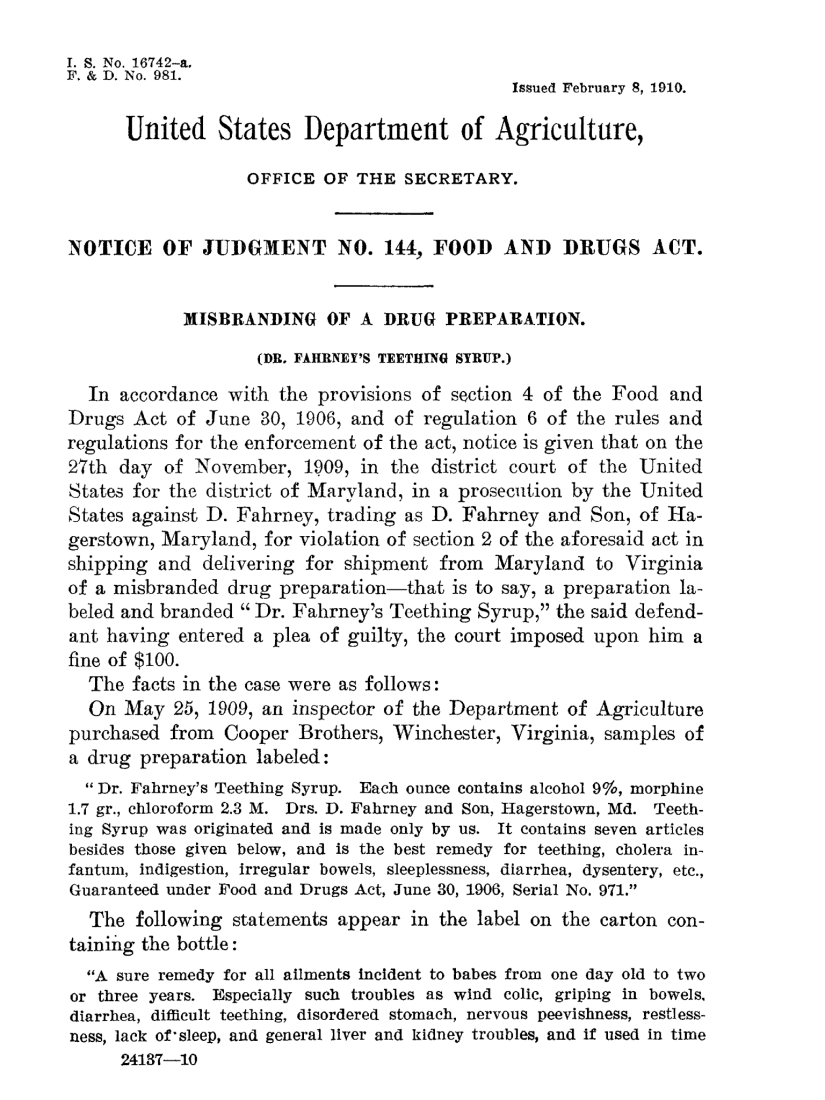One of the first things I explored here was the ravine. It runs through the property along the northern and eastern borders. By definition, a ravine is a narrow, steep-sided valley commonly eroded by running water. In this case the water comes from drainage of the surrounding farmland created by rain or melting snow. It begins somewhere on the northwest part of our property. We haven’t quite discovered exactly where it originates. That’s a project for warmer weather when the water is running. The ravine creek flows along the north edge of the property, joins another from the east then cuts under our driveway through a metal culvert.
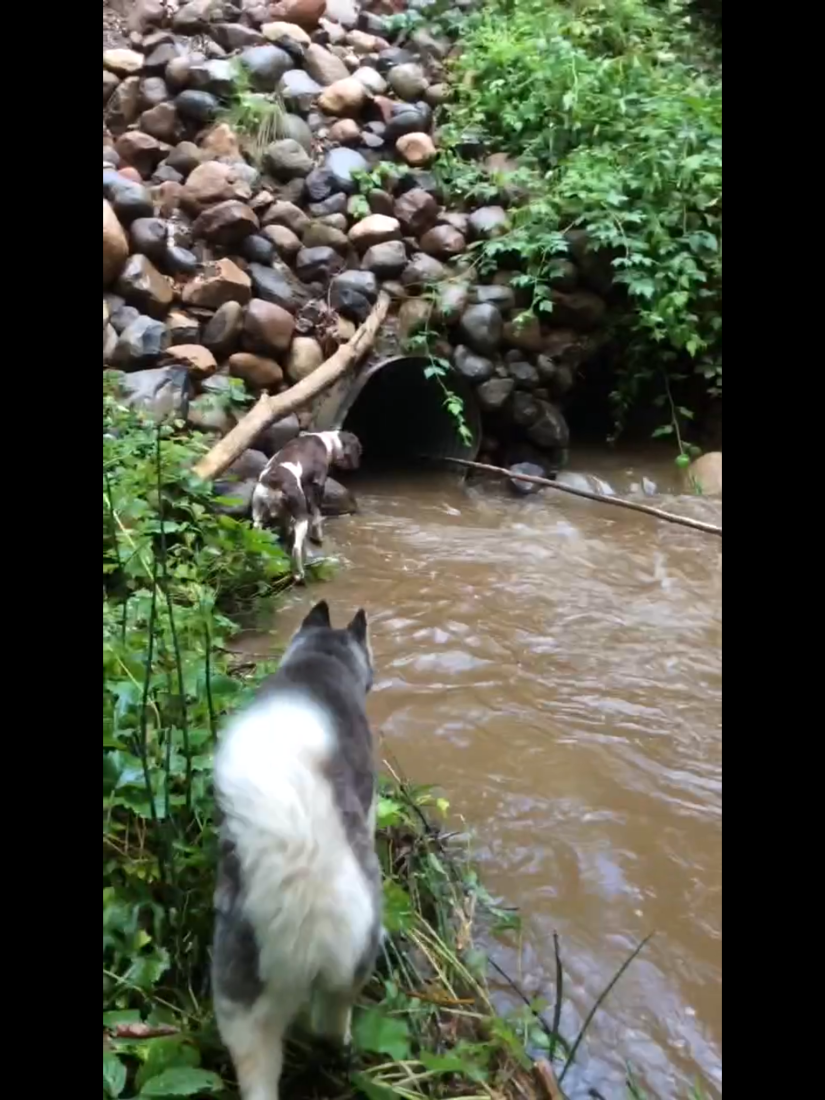

It continues to meander through the property where it eventually goes through a larger concrete culvert big enough to stand in. From here it runs under the road that borders our property on the east. After that I’m not sure where it goes. Again, warmer days for such expeditions.
The water in the ravine has gotten very deep during the heavier summer storms. We’ve seen it rise 8-10 feet deep at times where it backs up a bit before going under the driveway. The neighbors have told us that the most recent owner let the logs and debris build up and block the culvert there which caused the water to rise over the driveway and wash it out. I bet that was an expensive mistake. We’ll have to be diligent in the removal of debris.
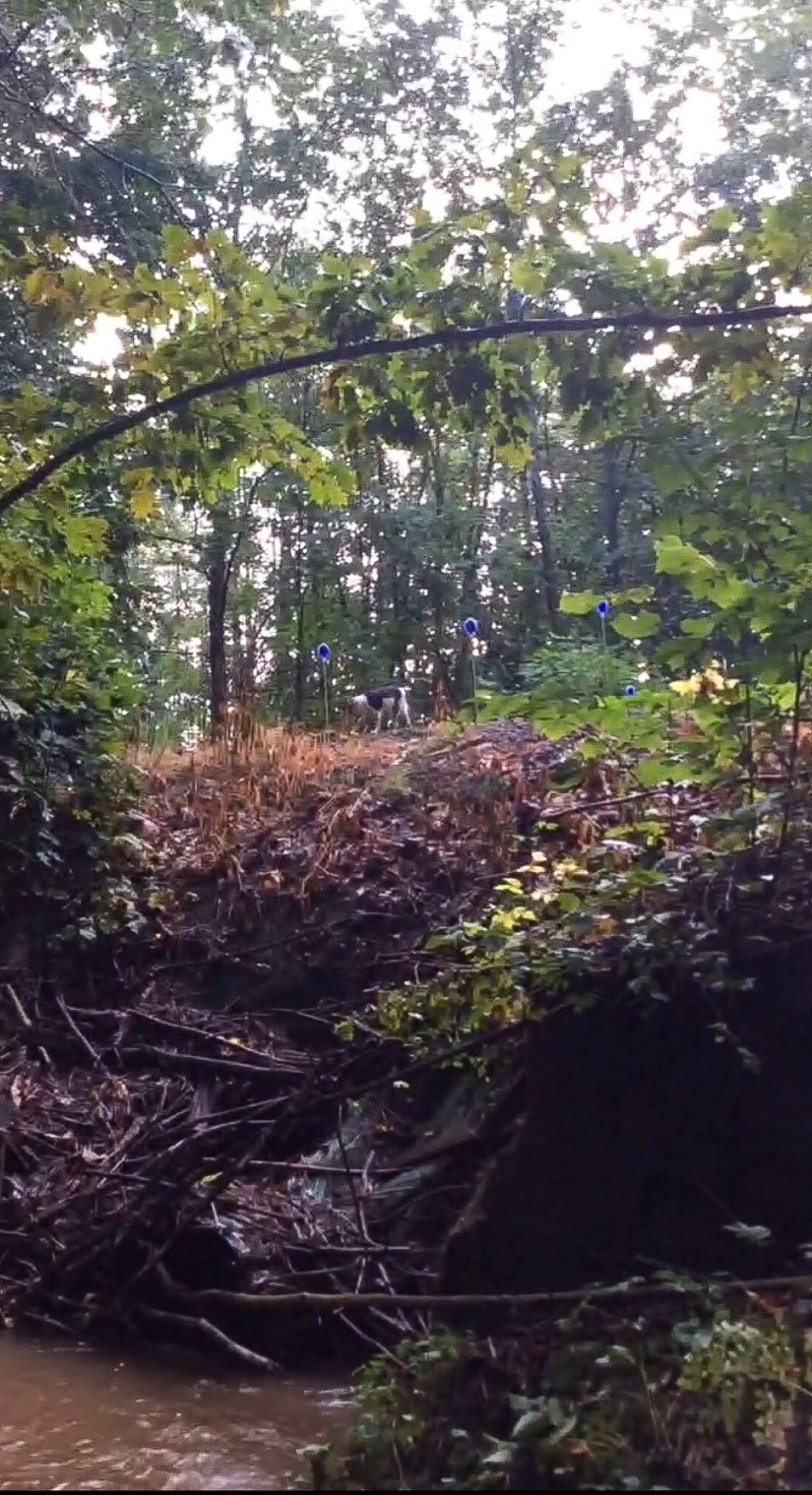
Remmy is on the driveway where the creek flows through the culvert below. This is where the water backs up and rises during heavy rain. The branches have to be removed frequently to keep it from plugging the culvert and flooding out the driveway again.
Spelunking for Junk
Trash or Treasure?
I soon found the ravine had another curious purpose besides carrying the water through. It is a graveyard for decades of trash. We discovered this while walking the property in the early stages of buying it. There were piles of glass bottles, jars, metal cans, tires, farm equipment, corrugated metal panels and rusty fencing buried and not buried. After speaking with our 87-year-old neighbor, Mike, and a few other old timers, I realized why there was so much trash in the ravine. It makes sense when you think about it: back in time, before there were city landfills and garbage trucks, where did people put their trash? Anything that couldn’t be reused or burned up was buried in the ravine where it remained unseen under cover of the forest and heavy clay soil. Trash collection didn’t start until the late 1930’s in populated cities and much later for rural areas. All these layers of junk were like a timeline of sorts. A look into the past…
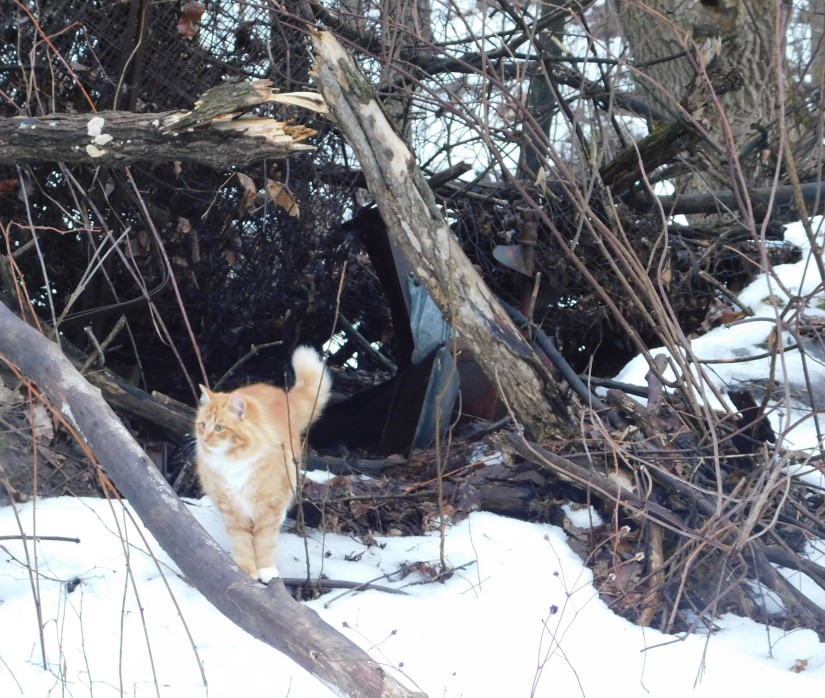
While sorting through piles of smaller items, we came across Minnesota license plates. Apparently, there are entire automobiles back there. As Roger (the last Vacinek to own the farm) said, they buried their vehicles after they were stripped of any useful parts. We’ve found four license plates so far and we haven’t even scratched the surface!
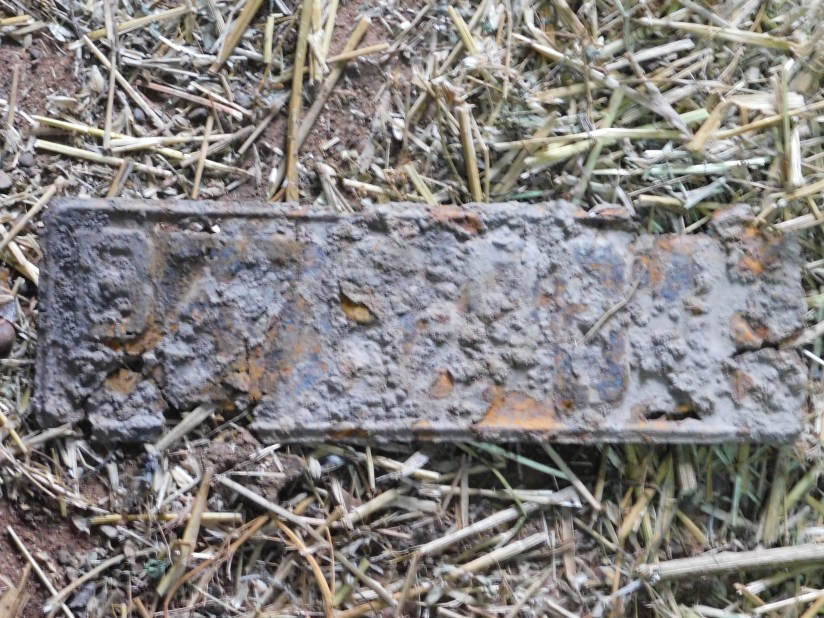

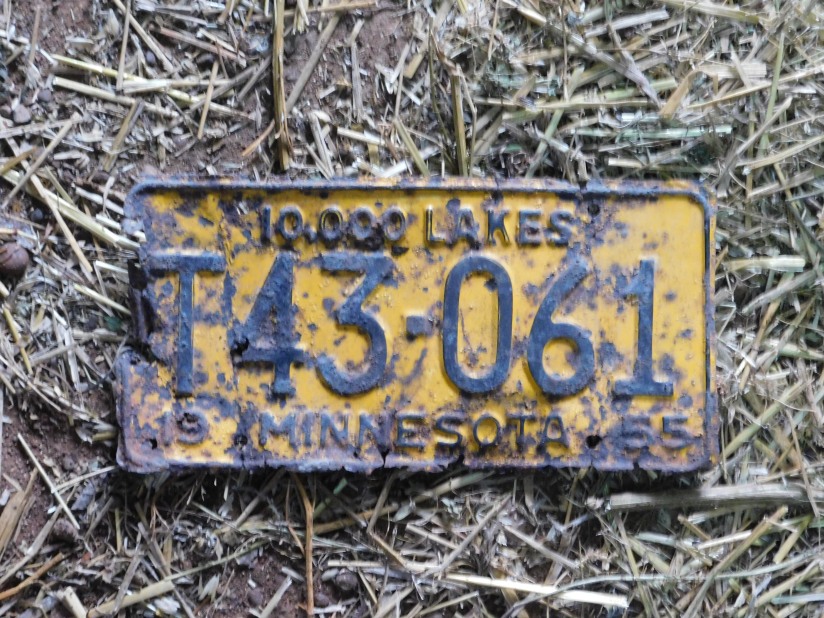

Every time it rains heavily a fallen tree or debris may partly block a section of the creek forcing the fast-moving water to rise into another area of the steep banks. This uncovers new pockets of treasure that couldn’t be seen before. It seems the pockets of trash are endless.
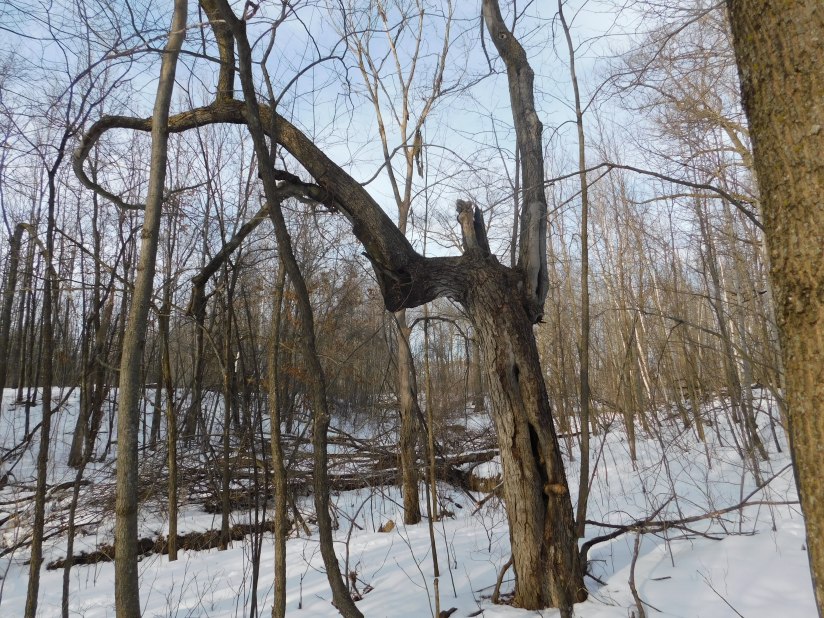
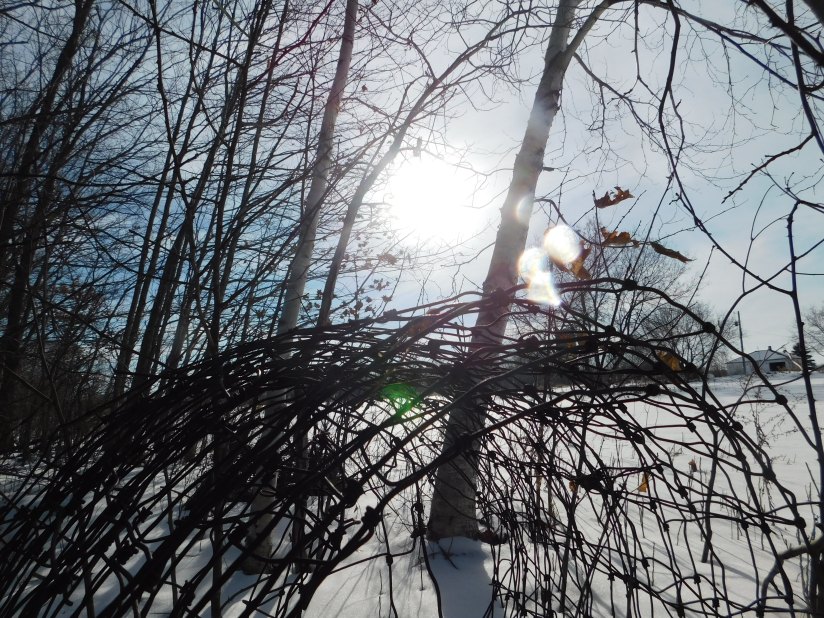
Some of our friends and family believe there may be a cache of cash waiting in all those piles of historical trash. Maybe some of this stuff is worth some money! Next I’ll show you what I’ve exhumed so far from the banks of the ancient ravine.
On the surface I found many piles of tin cans, glass bottles, and jars. A few of the oldest looking bottles dated back 100 years or even more! There is also a large piece of farm equipment rusting away.
It may be some sort of cutting machine for hay. I attempted to break the wheel loose to display in my future gardens but my attempts were futile. The sledge-hammer didn’t even make a dent. Can’t blame a girl for trying! I still have my eye on that wheel.
The glassware that I’ve found so far has been very fascinating. To think that I’m holding a bottle or jar that was used so long ago. Here are a few of the best ones so far:
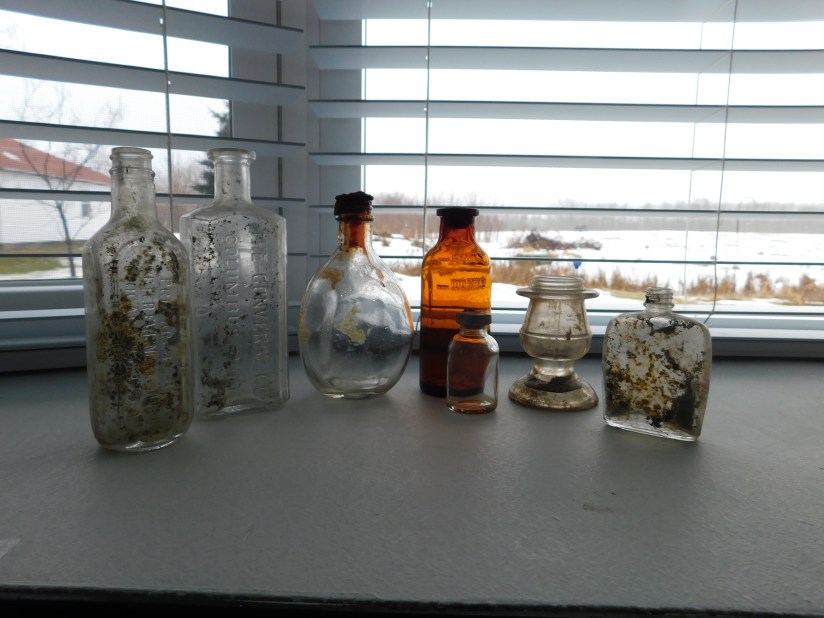
The bottle on the far left was embossed with these words:
PREPARED BY
DR PETER FAHRNEY & SONS CO.
CHICAGO, ILL. U.S.A.
After a little online research it was clear that “Doctor” Peter Fahrney wasn’t really a doctor at all but rather a quack who produced remedies or “proprietary medicines” as they were called back then. Sure he had some medical information from books his father and grandfather used before him but this and a small amount of college was all he had.
‘Doc’ Fahrney’s medicines were family recipes passed down from generation to generation. Dr. Peter Fahrney (1840-1905) was the grandson of the early Dr. Peter Fahrney. He manufactured these ‘remedies’ from around 1869 to about 1900. Dr. Daniel Fahrney, a cousin of Peter, started his own manufacturing in Hagerstown, Maryland. Other heirs to the Fahrney name started selling their own lines of these concoctions. Remedies that claimed to cure everything from teething pain and colic to health restorers, worm syrup, liniments, and cures for consumption (tuberculosis). Peter built his ’empire’ and became a rich man as did others with the Fahrney name. His office and manufacturing plant burned to the ground with the Great Chicago Fire of 1871. The fire left a one by four mile path of destruction which included the business district and the factory in which these elixirs were made. After the fire, Fahrney rebuilt and continued manufacturing these potions and lotions until around 1900 when the Victor Remedies Company bought the rights to all of the Fahrney brands.
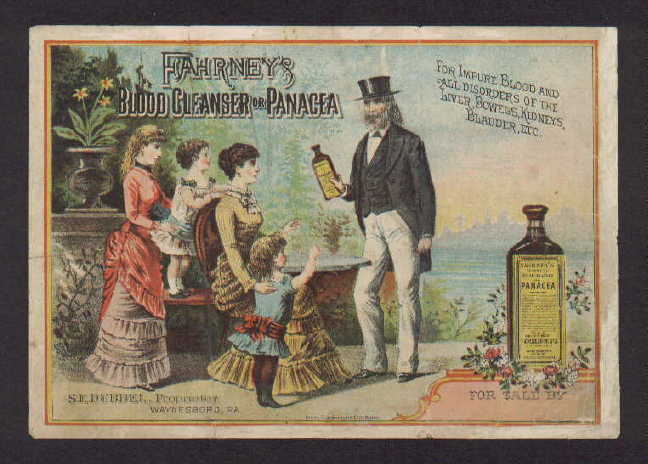

The first ad shows a small child reaching for the amazing panacea. To my horror, I discovered that these medications were deadly concoctions and the child probably wants more because this panacea contained morphine, cocaine and/or other highly addictive, harmful ingredients. Alcohol, Bromide and Chloroform were also common ingredients.
The second ad is more “testimonials” for one of these catch-all cures.

Eventually these quack companies were slapped with lawsuits and legal complaints. A man, Dr. Arthur J. Cramp, who lost his daughter to one of these dangerous ‘medicines’, wrote a book called Nostrums and Quackery in 1912. Dr. Cramp wanted to rid the world of such evils and exposed the trickery and dangerous products these companies produced. Many of these “nostrums” were nothing but water, alcohol, sugar, herbs or other flavorings such as vanilla and cinnamon. The United States Department of Agriculture created the FDA (Food and Drug Administration) in 1906. it’s job was to test these products to determine their ingredients and to prove their effectiveness or ineffectiveness and safety. This helped prevent people like Fahrney from misleading the public to think these products were safe to use. The judgement in the next photo was brought against D. Fahrney for the “misbranding of a drug preparation”. He was fined $100.
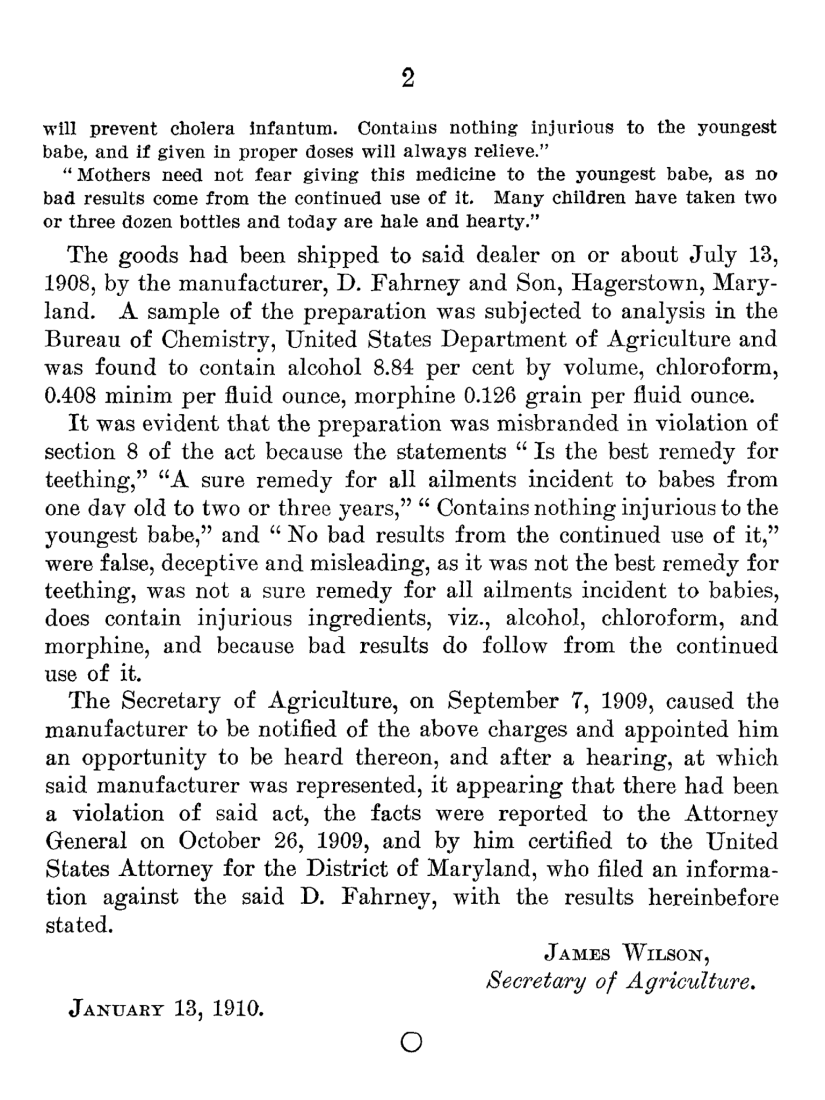
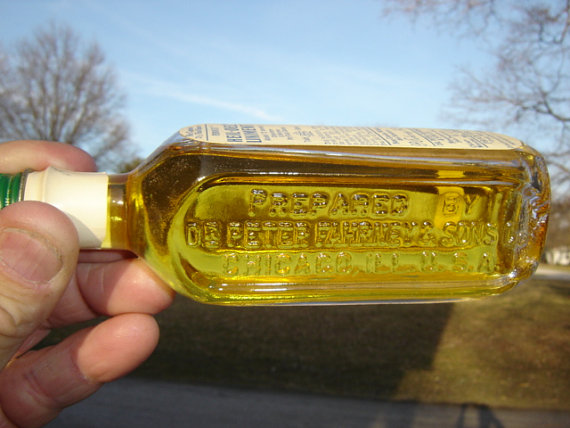
Even though it has a fascinating (almost horrifying) history behind it, my Dr. Fahrney and Sons bottle is only worth about $10!
Another bottle I found had these words embossed on it:
THE CONVERSE CO.
COLUMBUS, OHIO
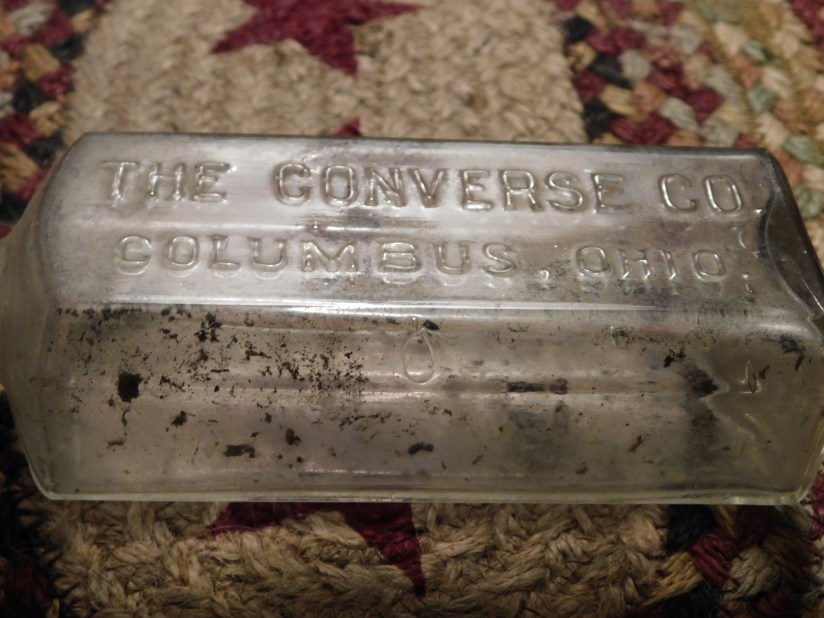
I did some research on this nostrum from the early 1900’s. The purpose of this remedy was to treat epilepsy and was sold from around the 1890’s to the early 1900’s. Each 100 c.c. of the “Converse Treatment” contained ammonium bromide (a mild acid), calcium bromide (now used as an industrial drilling fluid) and potassium bromide. One daily dose of 4 teaspoons would have contained about 58g of potassium bromide. Even though potassium bromide was the best thing for seizures until phenobarbital in 1912, it was still a very dangerous drug in combination with the other bromides.
Harsh side effects and overdose were common. The dosage was very difficult to determine because it has a long half-life of 12 days in the blood. When too much is taken, it can actually cause rashes, weakness, psychosis, seizures and even coma. Long term use of bromides can result in adding to the victim’s already serious disease of epilepsy. They were used for decades, especially in sanitariums or hospitals. It is recorded that some of the medical facilities used over a ton of bromide each year. Today it is only legal for use on humans in Germany under extremely controlled conditions. It is most widely used a veterinarian treatment for seizures in dogs.
It is unclear exactly who began this company and if there was even a real doctor involved. There was an article in a 1911 New York Post newspaper that outlined the scheme this company used. Letters were sent to people on their mail order list (most of their sales were done by mail order) for the “Converse Cure” offering them gifts for names of people they may know who also suffer from epilepsy. Four names got you a dictionary, three names for a fountain pen, two names for a cook book and if only one name was given you got a song book. These new potential customers were sent hand written letters which were hoaxes. The letters were supposed to be from real people who had epilepsy and were cured with use of the “Converse Cure”. The letterhead pictures imply that there is a brick and mortar hospital where they saw patients, which there wasn’t. Plus, the letters were written from within the Converse Company. Copies of some of these old letters are floating around on the internet…



The company letterhead listed four men connected to it. Herbert E. Sanderson, Frank J. Dawson, Nathan Dawson, and Edgar J. Martin, M.D. Sanderson had been in the “patent medicine” business for forty years, Nathan Dawson was a lawyer, Frank Dawson was in the fire insurance business, and Martin, who was described on the letterhead as a “medical referee”, graduated from Medical College of Ohio in 1889 specializing in gynecology. Not exactly neurological specialists.


We’ve come a long way in science and medicine since these nostrums were popular. It seems that much of our history of science and medicine comes by learning from our mistakes. These nostrums were some of the first.
From what I can see, my Converse bottle is only worth about $40 on the high end.
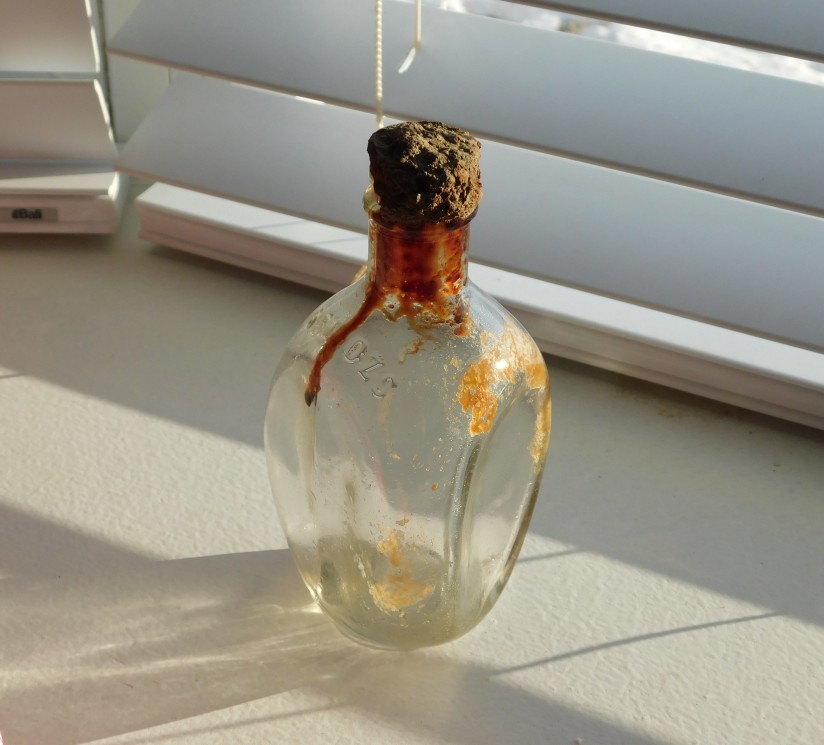
There are many of these type bottles back in the ravine. From what I’ve found, they are called “pinch” or “dimple” bottles and probably held some kind of whiskey. A company called Haig is my best guess since their products resemble my bottle.
These pinch bottles were made from about the 1950-1970 so they probably aren’t worth very much. I wonder just how many are back there.
These two syringe bottles probably aren’t very old either. There are similar bottles used today for animal medicines and inoculations.
These look like they may be perfume bottles. The one on the left could have been full of lotion or creamed perfume and the one on the right looks to be a liquid cologne or perfume bottle.
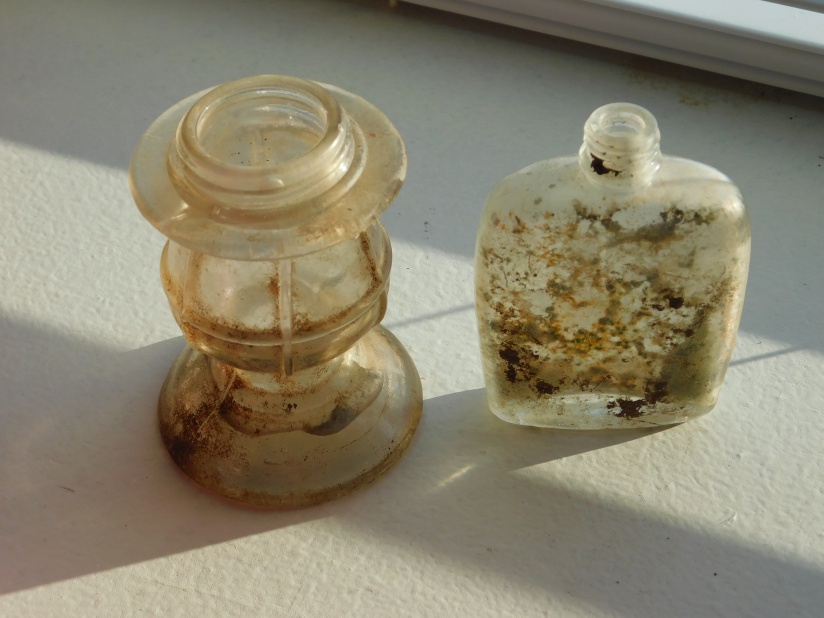
Many bleach bottles are buried back there too. This is a Hilex bottle from somewhere in the 1930’s and would’ve had a rubber stopper. It too isn’t worth very much but is still fun to find in such good shape.
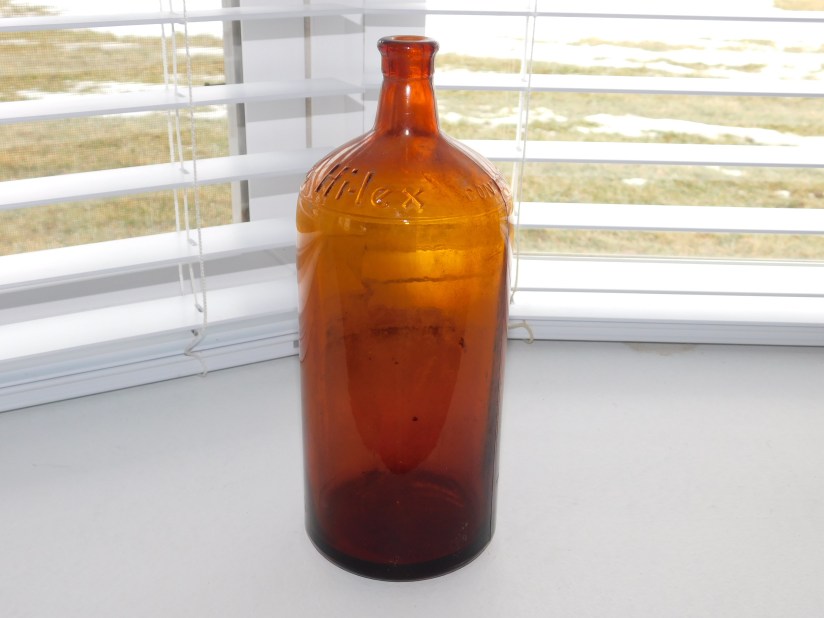
This tractor was one of my favorite finds. I haven’t researched it yet and I don’t see any distinguishing marks to identify its maker since it is mostly rusted. It’s made completely of metal except the back tires which still have their rubber on them. A child’s toy from who-knows-when. 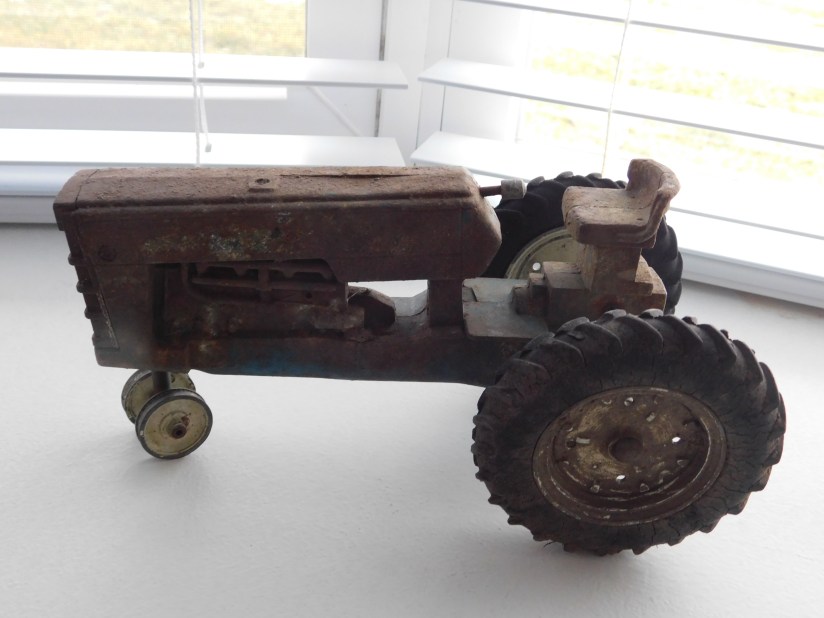
This spherical rock was in the middle of the creek bed in the ravine and was found on a day when the water was very low. I first thought of several wacky possibilities. Is it Fred Flintstone’s bowling ball? Since there aren’t any finger holes, I quickly ruled it out. Is it a meteorite? Since meteorites are usually black and/or shiny and glassy, I also ruled out this possibility.
After some online research I could only come up with one conclusion: the rock was caught in a pocket or “pothole” in the rocks of the creek bed where it spun and spun with the current, chipping away over time to eventually form a ball shape. I saw no evidence of any such spot when I found it but I’m sure it could’ve washed downstream with debris from its original spot. A curious find, indeed!

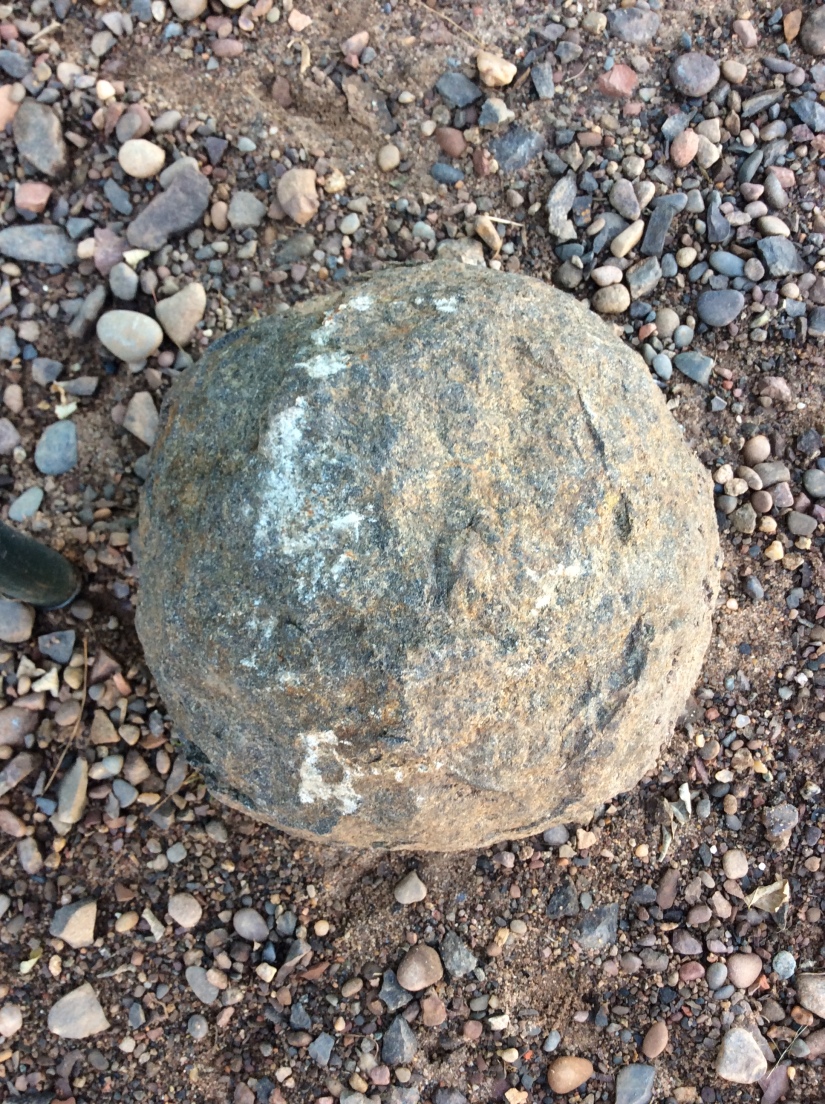
I got a closer look at some of the of the foundations from buildings around the property. One of them was deep and full of trash. In the summer without the cover of snow, at least two bowling balls can be seen in here.
One wall of a deteriorating hog house foundation was concealing the giant blades of an old wind mill. It would be fun to bend the parts back into shape and repurpose them somehow, any ideas?
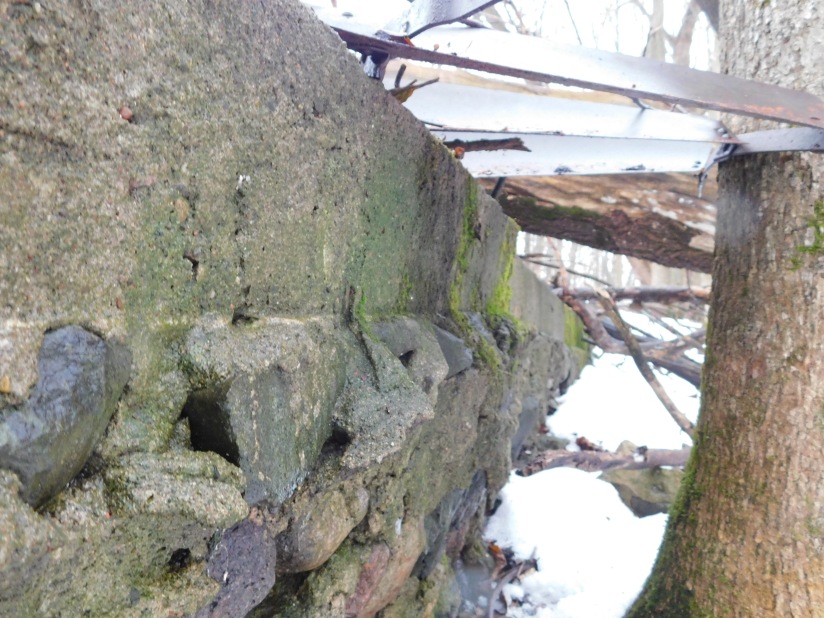

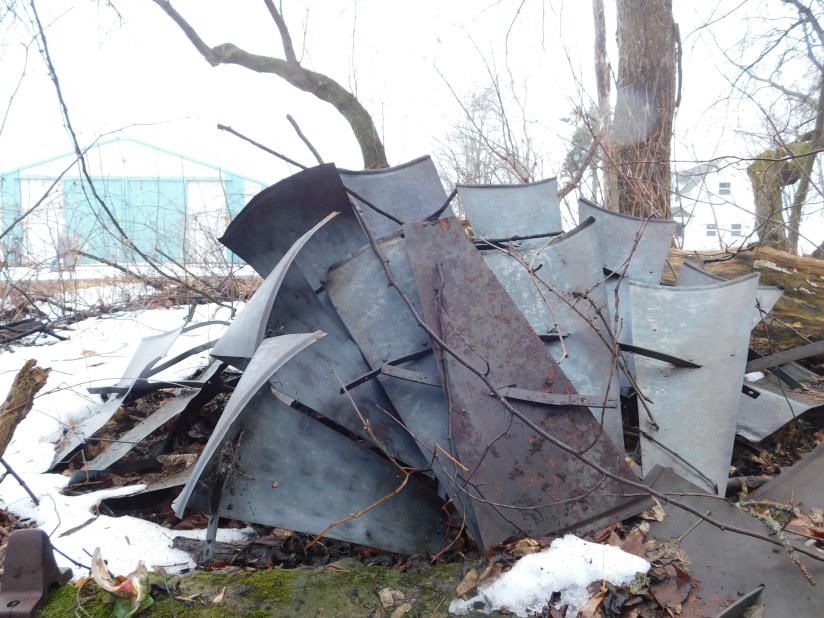
Complete sections of old windmill blades – 2016
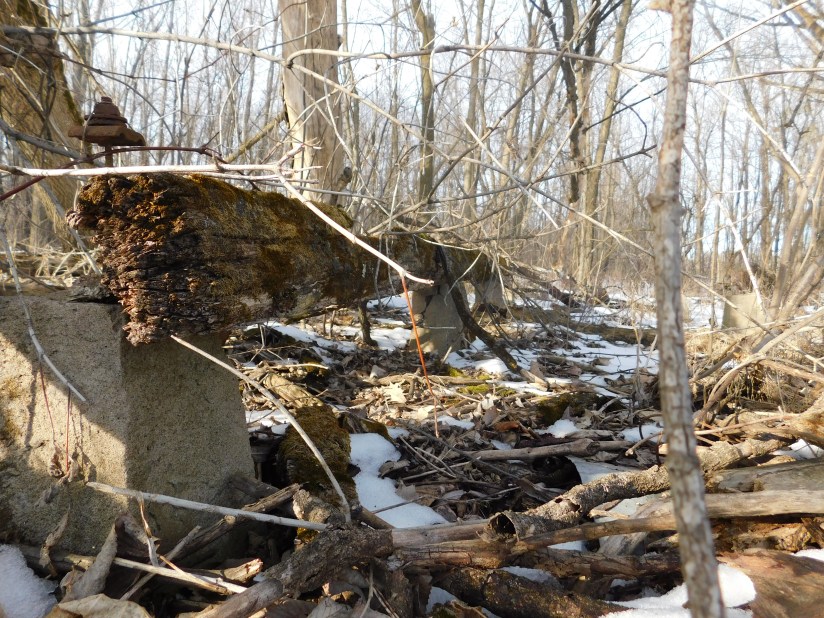
Former owner of the farm, Roger Vacinek, said there once stood a glorious red barn that his father built in 1954. According to Roger, the owners after him purposely burned this gem to the ground for an unknown reason. What a relic it would be today!

The barn when it was new in 1954
The only evidence of the old barn is some piles of rubble and an old concrete loading ramp. The present day garage is on the far right edge of the photo.
One structure on the property that will probably outlast us all is the silo. We’re not sure when it was built but it shows hardly any aging. It is constructed of concrete “staves” or blocks with ridged grooves along each edge that lock together into a high strength shell. Metal bands are pulled tightly around the outside, compressing the blocks, giving it even more strength and stability. I’m afraid of heights and get dizzy just looking up the side of the silo to the top!
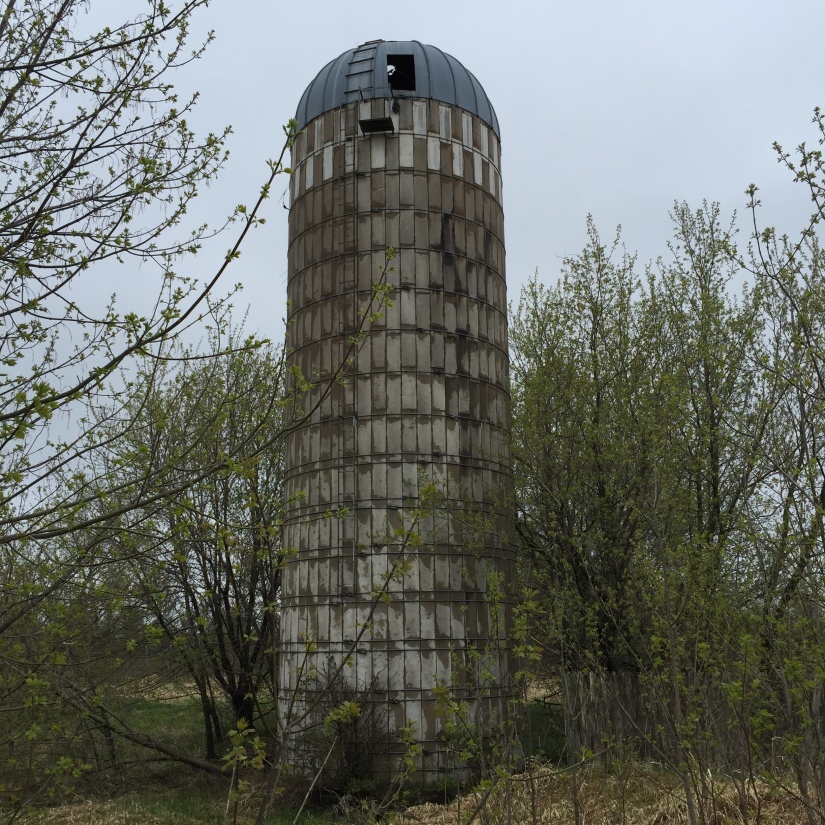
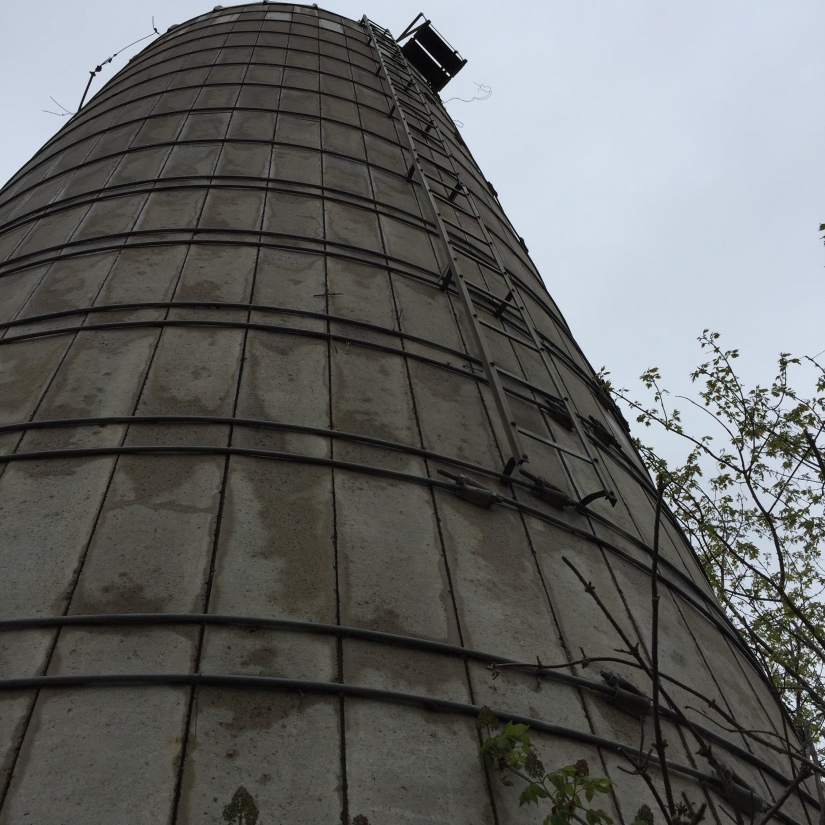
The inside of the silo still contains old machinery and is filled with decayed silage about 8 feet deep. A chute/staircase goes all the way to the top.
It would be fun (and expensive) to turn this into some sort of accommodations. A hunting lodge? An apartment? A friend even suggested that we run a zip line from the top of the silo to the ravine for a terrifying ride!
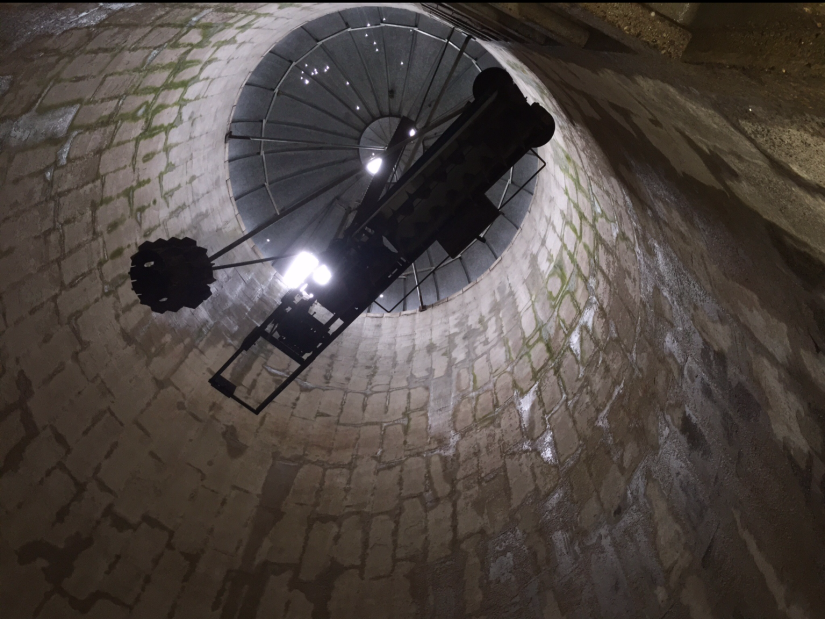
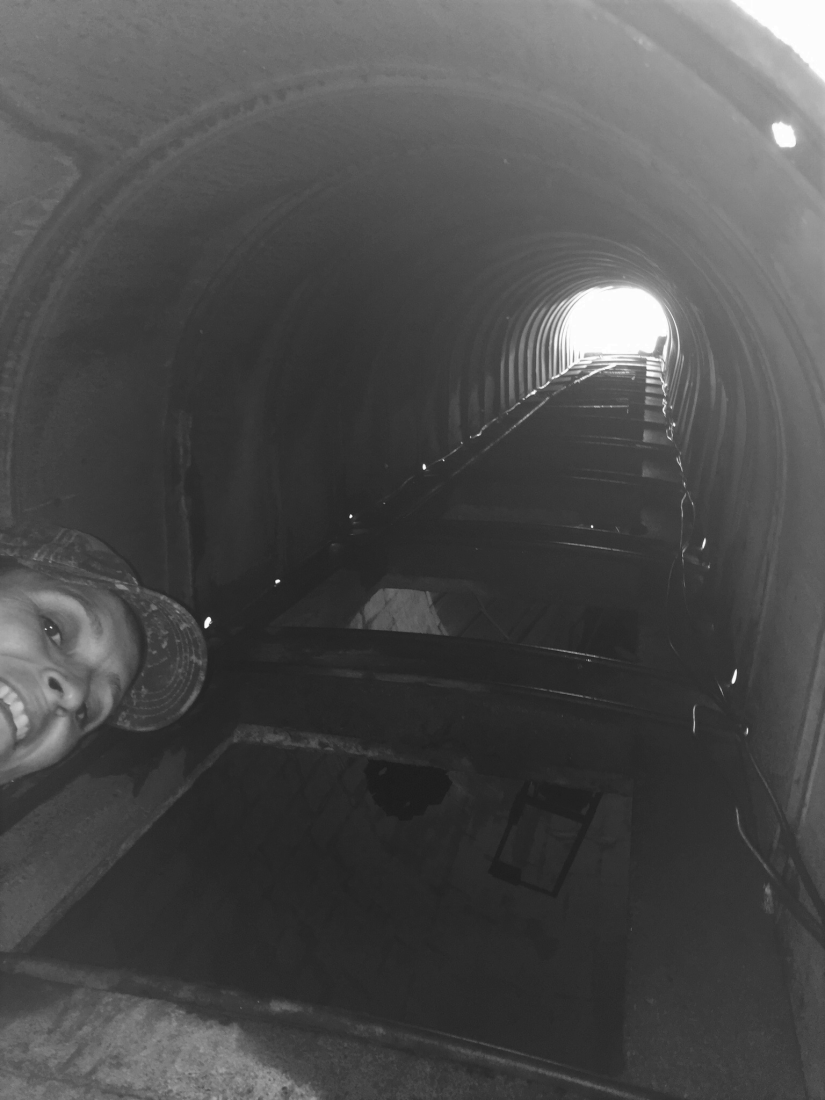
We’ve discovered a lot so far in the ravine and there is so much more to be uncovered. Although there is a large amount of useless trash, there’s sure to be some really great treasures too. Springtime will be a perect time for more spelunking in the ravine before the grasses and plants grow in and when the soil is thawed. C’mon spring!!































